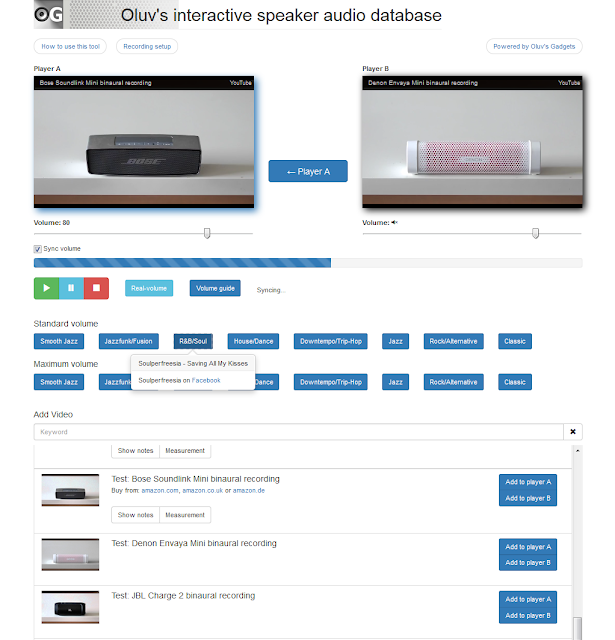I would like to briefly introduce the upcoming speaker audio database. All programming work has been meanwhile finished. I also finished the first recordings of most speakers I currently have at home, it will still take some time until I have all the content put together to finally publish everything. Here I just want to give you some information about the idea behind this database and what you can expect from it.
With this database I wanted to create a ressource that would allow cross-reference comparisons for each portable speaker that is included on a consistent basis. I wanted to provide as much data as possible for each speaker including audio samples, along the way with measurements, additional notes and links to any of my detailed reviews if available.
But the most important part is probably the audio part I guess, as this will give you a very first idea what kind of audio quality you can expect from a given speaker. I really wanted the result to be as close to the real sound as possible, therefore I settled for binaural audio recordings and chose microphones with a very natural and flat frequency response that I edit further with some fixed equalization to bring the sound even closer to reality. I will post more details about the exact recording procedure as soon as the database is up and running. But I think with my recording setup you will get a very realistic impression of how the speakers will sound in the room where they were recorded. The playback of binaural recordings requires headphones for optimum results and the better and more neutral sounding the used headphone is, the more realistic it will sound. Therefore avoid using any sounded Beats-crap, but rather studioquality headphones tuned for a flat sound reproduction. In my case I am using the B&O Beoplay H6 headphones, which sound extremely close to the recorded speakers as if they were standing directly in front of me. I tried some other headphones models and although even with the cheapest ones you will always notice the relative differences between 2 speaker recordings, only high quality headphones will give you that kind of "real-life" experience with all the subtle details captured. I also added the original recording for reference, so that you will be able to switch between a particular speaker and the original music, this way a kind of indirect comparison to reveal any sound coloration of a speaker will also become possible, something I was already experimenting with for my "speaker fidelity tests".
For the audio part of the database I selected short excerpts of 8 different genres to be played through each speaker (you can read more about the music selection here) which are recorded at 2 different loudness levels. One level is what I call "standard volume" and another one at each speaker's "maximum volume". "Standard volume" is a volume I settled for which is comfortable to listen to, without being too loud or too soft and one that even most smaller speakers can reach. To bring this into some context: this is about the highest volume level of a Jambox, although the Jambox will already distort heavily at this level many other speakers being not that close to their limit will still play fine, but even a Bose Soundlink Mini (playing at around 70%) or an Infinity One will already sound dirty at this particular level due to their overly pushed bass. It didn't make much sense to record the speakers at even lower levels as the results would not be representative.
Standard volume is recorded with the speakers standing about 1m away. For a situation closer to reality the speakers are about 5m away for the maximum volume recording, because nobody would probably turn the larger speakers to the maximum while sitting directly in front of them.
The maximum volume part is to give you an idea how loud a speaker can play compared to the other ones, but also how good it is able to fill the room with sound and last not least if it is usable at all at maximum volume because of too strong distortion etc.
As both standard and maximum volume recordings are recorded at different gains, there is also a "real volume" switch which will bring both into the same relation to each other again when activated. This together with an additional "volume guide" part will allow you to use my voice as rough guide in order to get the correct listening loudness thus you will be able to hear the recordings with the actual loudness the speakers were playing in reality.
Of course this tool cannot replace the listening experience you get in real life, but I think this is as close as you can get in "virtual life".
Please understand that as I wanted to make the database accessible for free, I have to rely on ads and affiliate links but also voluntary donations to keep it alive. Therfore so far everything is based on Youtube and their adsense service. I am not quite sure how helpful and successful this database may become in future, but for an even better experience and improved audio-quality I might switch everything to a subscription based offer because much features I wanted to include are not possible through the Youtube-solution. You have to know that this all not only takes lots of time to create, but also lots of money. So either I will have to try monetizing it in some way or the other, or I will have to stop doing it if I cannot afford it anymore.
From what I can say now, I think this database will really become something quite uniqe, and I am enjoying playing with it a lot! I hope you will enjoy it too and hope you can still be patient a little bit!
Thanks, your O.

EmoticonEmoticon